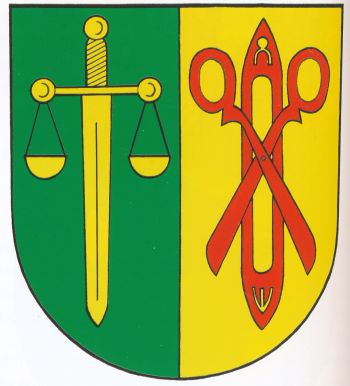Gingst: Difference between revisions
Knorrepoes (talk | contribs) m (Text replacement - "/Arms of " to "/Arms (crest) of ") |
Knorrepoes (talk | contribs) m (Text replacement - "{{media}}" to " {{de1}} {{media1}}") |
||
| Line 26: | Line 26: | ||
[[File:gingst1.jpg|center|alt=Wappen von {{PAGENAME}}/Arms (crest) of {{PAGENAME}}]] | [[File:gingst1.jpg|center|alt=Wappen von {{PAGENAME}}/Arms (crest) of {{PAGENAME}}]] | ||
{{ | |||
{{de1}} | |||
{{media1}} | |||
[[Civic Heraldry Literature - Germany|'''Literature''']]: Schütt, 2002 | [[Civic Heraldry Literature - Germany|'''Literature''']]: Schütt, 2002 | ||
Revision as of 11:52, 26 December 2022
This page is part of the German heraldry portal Deutsche Wappensammlung |
Heraldry of the World |
|
German heraldry:
|
Selected collector's items from Germany:
|
GINGST
State : Mecklenburg-Vorpommern
District (Kreis) : Vorpommern-Rügen (until 2011 Rügen)
| German |
Gespalten von Grün und Gold; vorn ein gestürztes goldenes Schwert mit runden Parierstangenköpfen, an denen jeweils eine herabhängende goldene Waagschale befestigt ist; hinten ein pfahlweise gestelltes rotes Weberschiffchen, welches mit einer gestürzten und geöffneten roten Schere belegt ist. |
| English | No blazon/translation known. Please click here to send your (heraldic !) blazon or translation |
Origin/meaning
The arms were granted on July 15, 1999.
The arms show on the right half a sword and scales, symbols for justice and the former Gardvogtei Gingst with its court of justice. The left half shows a spindle and scissors, wymbolising the traditional weaving and cloth making in the area. The green field stands for the forests and nature in the municipality, whereas the golden field is taken from the expression "Handwerk hat goldenen Boden" (handicrafts are a rich base/soil).
Literature: Schütt, 2002



